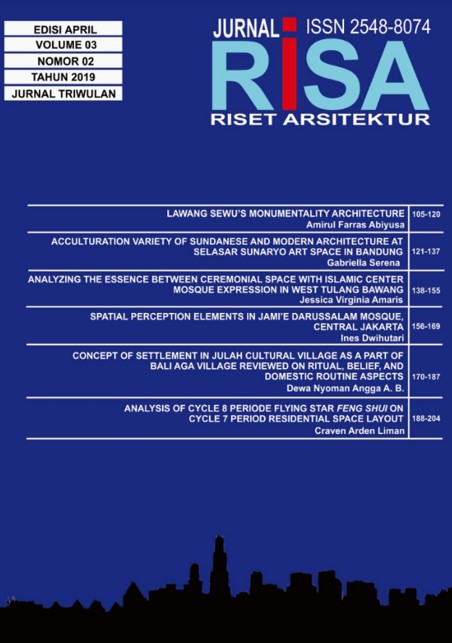SPATIAL PERCEPTION ELEMENTS IN JAMI’E DARUSSALAM MOSQUE, CENTRAL JAKARTA
DOI:
https://doi.org/10.26593/risa.v3i02.3277.156-169Abstract
Abstract- In the course of the development of Islam since the time of the Prophet Muhammad until now, the strategic position of the mosque is not only as a place of worship but also as the center of Islamic Introduction. As we know that establishing a mosque is a culture that has been rooted in the life of Muslim society. The founding principle of the mosque comes from the teachings contained in the Qur'an and Hadith. However, the two sources did not disclose and include the building and physical codes of the mosque. All of it is left to the people to design their own buildings and physical mosque in accordance with the conditions of the local community. The mosque in Indonesia is developed into two forms, the first being a form influenced by the local culture. The second is a form influenced by middle eastern culture. Then, a mosque with a different shape from the two previously described forms began to appear. One of the mosques is the Jami'e Darussalam, the mosque which became the object of research.
The study was conducted based on a preliminary study conducted by studying the theory of space perception put forward by Bert Bielefeld and the theory of space perception in the mosque. From the existing theory can then be formulated an indicator of the perception of space needed in a mosque. Existing indicators are then used to research buildings with a focus on the perception of space. The result of object study analysis then further be processed through the analysis table so that it can be inferred the space forming element that influence the human perception on the mosque.
From the research, it is found that the perception of space needed in a mosque is only in the prayer room of Jami'e Darussalam Mosque, but not in other spaces. This is because the character of different space-forming elements in each space.
The benefit of this research for the general public is to increase knowledge about the perception of space needed in a mosque and how the perception of space can be realized. Meanwhile, for the architects and mosque institutions, this research can add knowledge about the perception of space in a mosque and how to design the elements of space to be able to realize the perception of space.
Key Words: elements of space formation, perception of space, mosque












